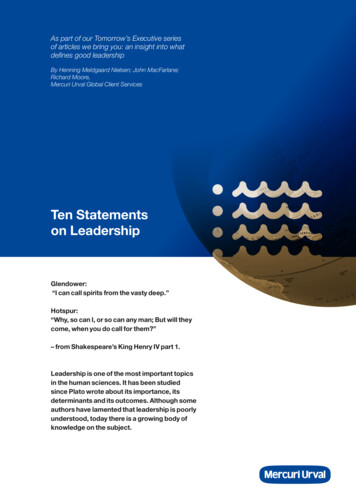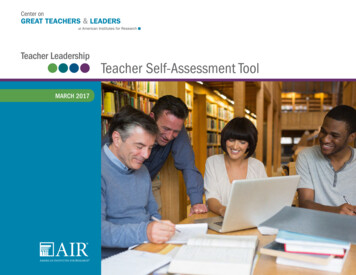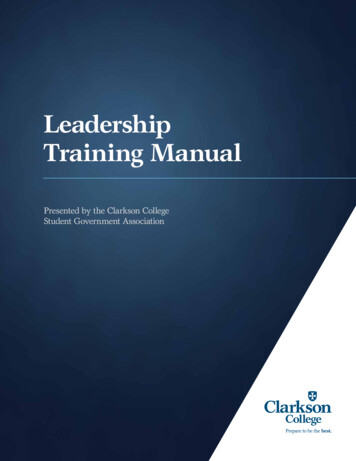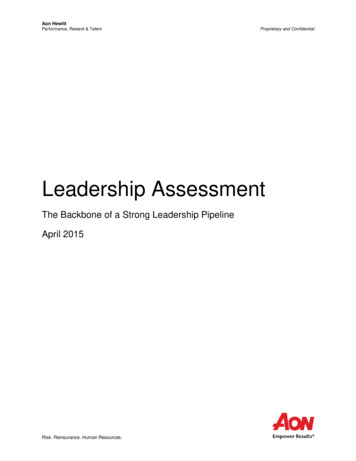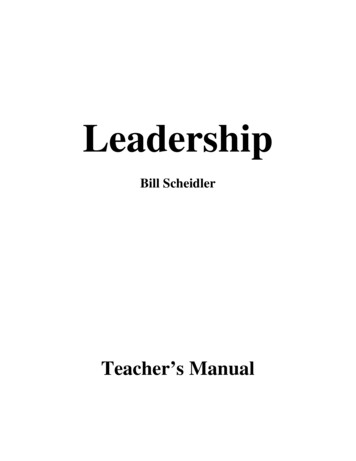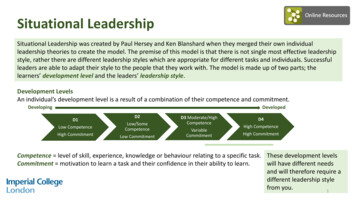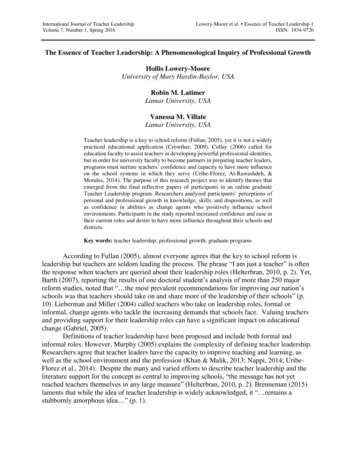
Transcription
International Journal of Teacher LeadershipVolume 7, Number 1, Spring 2016Lowery-Moore et al. Essence of Teacher Leadership 1ISSN: 1934-9726The Essence of Teacher Leadership: A Phenomenological Inquiry of Professional GrowthHollis Lowery-MooreUniversity of Mary Hardin-Baylor, USARobin M. LatimerLamar University, USAVanessa M. VillateLamar University, USATeacher leadership is a key to school reform (Fullan, 2005), yet it is not a widelypracticed educational application (Crowther, 2009). Collay (2006) called foreducation faculty to assist teachers in developing powerful professional identities,but in order for university faculty to become partners in preparing teacher leaders,programs must nurture teachers’ confidence and capacity to have more influenceon the school systems in which they serve (Uribe-Florez, Al-Rawashdeh, &Morales, 2014). The purpose of this research project was to identify themes thatemerged from the final reflective papers of participants in an online graduateTeacher Leadership program. Researchers analyzed participants’ perceptions ofpersonal and professional growth in knowledge, skills, and dispositions, as wellas confidence in abilities as change agents who positively influence schoolenvironments. Participants in the study reported increased confidence and ease intheir current roles and desire to have more influence throughout their schools anddistricts.Key words: teacher leadership; professional growth; graduate programsAccording to Fullan (2005), almost everyone agrees that the key to school reform isleadership but teachers are seldom leading the process. The phrase “I am just a teacher” is oftenthe response when teachers are queried about their leadership roles (Helterbran, 2010, p. 2). Yet,Barth (2007), reporting the results of one doctoral student’s analysis of more than 250 majorreform studies, noted that “ the most prevalent recommendations for improving our nation’sschools was that teachers should take on and share more of the leadership of their schools” (p.10). Lieberman and Miller (2004) called teachers who take on leadership roles, formal orinformal, change agents who tackle the increasing demands that schools face. Valuing teachersand providing support for their leadership roles can have a significant impact on educationalchange (Gabriel, 2005).Definitions of teacher leadership have been proposed and include both formal andinformal roles. However, Murphy (2005) explains the complexity of defining teacher leadership.Researchers agree that teacher leaders have the capacity to improve teaching and learning, aswell as the school environment and the profession (Khan & Malik, 2013; Nappi, 2014; UribeFlorez et al., 2014). Despite the many and varied efforts to describe teacher leadership and theliterature support for the concept as central to improving schools, “the message has not yetreached teachers themselves in any large measure” (Helterbran, 2010, p. 2). Brenneman (2015)laments that while the idea of teacher leadership is widely acknowledged, it “ remains astubbornly amorphous idea ” (p. 1).
International Journal of Teacher LeadershipVolume 7, Number 1, Spring 2016Lowery-Moore et al. Essence of Teacher Leadership 2ISSN: 1934-9726The Case for Legitimizing Teacher LeadershipThe concept of teacher leadership as a powerful force in school reform is not new.According to Bond (2015), teacher leadership was recognized as an important field of study inthe 1980s and since then, articles and books have been written on the subject. Crowther (2009)described a decades-long association with teacher leadership initiatives in four countries andconcluded a convincing relationship between teacher leadership and enhanced schoolimprovement. Yet, according to Crowther, the potential of teacher leadership has not been“actualized.” Collay (2006) called for education faculty to embrace the concept of teacherleadership within educational leadership pedagogy and to become partners in preparing teacherleaders. Harris, Lowery-Moore, and Farrow (2008) argued for the inclusion of teacher leadersinto teacher preparation programs. According to Lieberman (2015), for teacher leadership tobecome more widely recognized, researchers need to explore and understand practices thatnurture teacher leadership skills. Teachers need to perceive their work as an act of “sociallyresponsible” leadership, developing a powerful “professional identity” (Collay, 2006, p. 131132). Lieberman and Miller (2004) note, “When teachers cast off the mantle of technical andmanaged worker and assume new roles as researchers, meaning makers, scholars, and inventors,they expand the vision of who and what they do” (p. 11). However, the culture of the school canform a great barrier to those who attempt to cast off these roles. In a meta-analysis of twodecades of research on teacher leadership, the Center for Comprehensive School Reform andImprovement (2005) noted that it is clear that features “ of school structure and culture thatstand in the way of teachers being able to facilitate improvement may prove detrimental to thesustainability of improvement efforts” (p. 4).The Resistance to Teacher LeadershipLambert, Collay, Dietz, Kent, and Richert (2007) stressed that teachers are the greatestinfluence on students’ academic success yet seldom lead the reform efforts. “Therefore, manyteachers do not see themselves as leaders of adults or of the profession” (p. 107). Gabriel (2005)described teachers as essential to students’ academic success and stressed that only through theirrecognition of their personal leadership capabilities can teachers have maximum impact onstudent achievement. Helterbran (2010) shared a comment offered by a master’s in educationstudent enrolled in a class in teacher leadership, “I think I have some leadership qualities, but Iam just a teacher” (p. 2). Teachers who do take on leadership roles within a school or district,formal or informal, break the “ stereotypical isolation familiar to most teachers ”(Helterbran, 2010, p. 4), violating the cultural norms of the teaching profession described in theCenter for Comprehensive School Reform and Improvement Research Brief (2005).Barth (2007) cited some of the reasons teachers may not choose leadership roles. There isa sense from some teachers that the principals do not want to share leadership. Other teacherscite the lack of recognition for their efforts when they take on informal leadership activities. Thelack of time and the personal values of teachers who want to make a difference in the classroomworking with students are among reasons for teachers not seeking leadership responsibilities.According to Brenneman (2015), “Advocates say the current interest in teacher leadership speaksto a need many teachers feel to influence education outside the classroom, without leaving it” (p.1). Finally, bureaucratic and institutional norms do not promote the idea of teacher leadership:“Something deep and powerful within school cultures seems to work against teacher leadership”(Barth, 2007, p. 10). Helterbran (2010) added that teachers often receive no compensation fortaking on leadership activities which involve more work and responsibility. Teachers are
International Journal of Teacher LeadershipVolume 7, Number 1, Spring 2016Lowery-Moore et al. Essence of Teacher Leadership 3ISSN: 1934-9726exhausted with the constantly changing reform efforts that often are replacing the last dazzlingprogram that has not had time to work. Teacher leadership initiatives may be seen as anothernew, short-lived initiative that does not actually bring change.The Impact of Teacher LeadershipKhan and Malik (2013) emphasized that promoting teacher leadership programs can aidin recruiting, motivating, and rewarding accomplished teachers. The National Commission onTeaching and America’s Future (2007) described the financial and personal cost of failure toretain teachers: “Teacher attrition is high, with 46% of teachers leaving the profession within thefirst 5 years” (Holland, Eckert, & Allen, 2014). Training teacher leaders is necessary forteachers to understand the informal and formal responsibilities of the teacher-leader role. Buchen(2000) argued that “the only leadership that will make a difference is that of teachers .Theyalone know what the day-to-day problems are and what it takes to solve them” (p. 35). Nappi(2014) cited the Wallace Foundation study (Louis, Leithwood, Wahlstrom, & Anderson, 2010)findings that high student achievement was found in schools that valued input from allstakeholders, including teachers.Training can encourage teachers’ willingness to initiate positive changes in their schools.Teacher leadership programs must nurture the development of confidence and the desire ofteachers to move outside their comfort zone and embrace the idea of exerting influence on schoolreform (Helterbran, 2010; Uribe-Florez et al., 2014). According to Helterbran (2010), teachersmust reject the “just a teacher” mantra (p. 363). Teachers must be leaders who identify thebarriers to student success and take the initiative in overcoming the roadblocks.The purpose of this research project was to identify themes that emerge from master’slevel teacher leadership program participants’ self-reflection of personal and professional growthand perceptions of self as change agents who positively influence school environments. As aqualitative phenomenological research project focusing on the participant’s perspectives ofprofessional growth in knowledge, skills, and dispositions as a potential leader, this research willadd to the understanding of factors that contribute to teacher leader training that can enhancestudent achievement, professional school environments, and personal and career satisfaction.MethodologyIn our effort to understand how students in an online graduate Teacher Leadershipprogram grew as teacher leaders, we agreed that we felt the final program reflection papers werea rich repository of qualitative data that we could access easily. These reflection papers wereexisting data submitted by students as their comprehensive exam and had been archived in twoplaces: (a) on the hard drive of one of the researchers and (b) on Tk20, an electronic databasesoftware (only available beginning at the end of 2012). All three researchers had taught and/orgraded the course at least three times, with two researchers having taught and graded the coursenumerous times across an eight-year period.
International Journal of Teacher LeadershipVolume 7, Number 1, Spring 2016Lowery-Moore et al. Essence of Teacher Leadership 4ISSN: 1934-9726Background of the Master’s in Teacher Leadership ProgramIn 2006, Lamar University’s Teacher Education Department offered master’s degrees inElementary Education and Secondary Education. The number of applicants was small and thedepartment faculty studied alternatives to these two programs that no longer attracted numbers tosustain the efforts. The studies in teacher leadership evidenced a promising trend indicating thedesire for teachers to be involved in leadership roles, both formal and informal. Researchersindicated that the concept of teacher leadership addressed the isolation of the teaching professionoffering an antidote to the ill-conceived phrase “I am just a teacher.” Authors of the studies onteacher leadership indicated that training teacher leaders resulted in stronger student performanceand higher teacher retention. Once the department members agreed to phase out the master’sdegrees in elementary and secondary education and to develop a master’s degree in teacherleadership, members searched for a framework on which to build the program. At that time therewere no explicit standards for teacher leadership. Program developers studied the InterstateTeacher Assessment and Support Consortium Standards (InTASC, 1992) and the National Boardfor Professional Teaching Standards (2002), as well as many other documents and programs towrite outcomes. It was decided that the master’s degree in teacher leadership program would beoffered online. Faculty members worked with instructional designers to develop interactive webbased courses. The first teacher leadership classes were offered in 2008. The program hasmaintained stable enrollment through the years. All three of the researchers have taught in theprogram and evaluated final portfolios. The growth and career development reflections wereparticularly intriguing and the researchers decided to use these documents to determine if theprogram was succeeding in developing teacher leaders. This qualitative study is one avenue foranswering that question.MaterialsThe documents that we analyzed were students’ “Professional Growth and Future Goals”paper. This paper was one component of students’ final portfolio, which served as theircomprehensive examination for the master’s degree. The review of the literature established thelegitimacy of teacher leadership; however, resistance to the application of the concept wasinternal and external. In order for teacher leadership programs to have the impact on teacherrecruitment and school reform described in the literature, teachers must grow professionally anddevelop confidence in their abilities as change agents.The guiding questions for the Professional Growth paper were (a) Where were youprofessionally when you began your studies in teacher leadership? (b) How have you grownduring the course of your studies? (c) Do you feel you have changed and how have thosechanges impacted you, your colleagues, and your students? (d) Where do you feel you are now inthis journey? (e) In what areas do you feel you still need to improve? and (f) What are at leastthree goals you have for your future growth in the area of teacher leadership?ProcedureWe selected a random, stratified sample of papers, with an intention of analyzing 90papers total: 30 papers for each of three categories (teachers in Pre-Kindergarten to 5th grade; 6thto 8th grade; and 9th to 12th grade), divided equally between three years (2010, 2012, and 2014).However, due to data availability constraints for the year 2010, we were only able to locate 5papers for 6th to 8th grade and 7 papers for 9th to 12th grade. Therefore, we analyzed 82 papersthat spanned grade levels and years in the program.
Lowery-Moore et al. Essence of Teacher Leadership 5ISSN: 1934-9726International Journal of Teacher LeadershipVolume 7, Number 1, Spring 2016The papers were categorized and compiled anonymously by one of the researchers andthen the documents were shared with the other team members. We employed a constantcomparative method of analysis (Merriam, 1998), looking for words and phrases related to fourstart codes indicative of growth and change, which were the key focus elements of the finalreflective paper: (a) how the students have grown professionally or in their careers; (b) in whatways they have seen themselves become a leader or a change agent; (c) what kind of leadershipstyle they find themselves using or engaged in (authoritative, collaborative, etc.); and (d) whatpersonal benefits they have accrued from their learning. We shortened these ideas to thefollowing start codes: (a) Professional growth—career; (b) See themselves as a leader—changeagent; (c) Perception of leadership style—change agent; and (s) Personal satisfaction—benefitsto self. The start codes proved to be cohesive and accurately described the data, though weconcluded that two additional areas of note were (a) participant response to the administrativeleaders around them and (b) participant placing value on lifelong learning. Secondary themesunder each of the start codes emerged and overlapped.One researcher used NVivo software to complete her analysis and the other tworesearchers used highlighters on paper to complete their analysis. Results between the methodswere consistent and were discussed at length in two data meetings attended by all threeresearchers, without significant disparities of interpretation. It was decided in these meetings thatan analysis of differences in coding for participating grade levels would not be undertaken butpossibly reviewed at a later time.FindingsThere is a great need for teachers to take on leadership roles, informal and/or formal, forpersonal and professional growth and to improve schools. Internal and external impediments toteachers becoming leaders make the transitions from “just a teacher” to “teacher leader” difficult.Graduate teacher leader preparation programs need to assist teachers in developing confidenceand professional identity as teacher leaders willing to be problem-solvers, change agents, andmentors who experience a high degree of professional and personal satisfaction.Perceptions of Professional and Career GrowthThe largest number of responses was gathered under the start code indicative of growthand change in the arena of professional and career development. Further, this growth seemed toparticularly situate itself within a new sense of (a) confidence and well-being as a teacher; (b) abetter use of research and assessment to drive curricular and instructional decisions with aconcomitant greater awareness of multicultural decision points; and (c) a deeper understandingof the relationship of the classroom and the classroom teacher to the school and the community.Evidence of each of these areas is discussed below.Confidence and well-being as a teacher. One student stated, “For the first time in mycareer, I feel comfortable, confident and resilient in my profession as an educator.” Anothernoted, “The journey has been motivating and I am a better teacher because of it.” Another suchgeneral statement was, “Learning about new educational theories and practices has made me amore effective teacher over the past year and a half.” Still another student wrote, “As I finishthis program, I know that I have reached my goal of improved classroom instruction.”
International Journal of Teacher LeadershipVolume 7, Number 1, Spring 2016Lowery-Moore et al. Essence of Teacher Leadership 6ISSN: 1934-9726Other students elaborated on specific improvements in instructional knowledge andskills. One noted,My exposure to new ideas and information has made me a better teacher and moreinformed colleague. I am working to find new ways to provide authentic learningexperiences for my students that will fit into my budget and utilize available resources.An additional elaboration noted that “I feel that my learning through these courses has benefitedmy students as I have been encouraged to evaluate my own teaching more frequently and toassess the needs of my students and adapt more quickly.” This factor of new confidence alsoextended to more complex teaching analysis and tasks as noted by this student:As a result of my studies and new growth in my craft, I am now more confident in mycapabilities in my classroom. The current school year has been especially challenging forme. My students’ needs both behaviorally and academically have been more varied andcomplex than my previous years combined. I have more students in RTI than previousyears as well. However, through my growth as a professional, I feel more confident thanever when working with the parents on these complex student issues.The remarks of these students clarified that their work in the Master of Teacher Leadershipprogram formed the basis of a generalized sense of confidence that pervaded all of their teachingactivities and actions.Better use of research and assessment. In the realm of professional and career growth,results of this review of reflective documents indicated that students in this program perceivedthemselves to have a stronger and increased use of research and assessment to drive curricularand instructional decisions. Some of the reflections indicated a greater awareness ofmulticulturalist aspects of the teacher role:Before my studies, I was not sure how I should address specific needs in the classroomand at times I did not know what to communicate with parents. However, I now havemuch more knowledge about a variety of student topics and how to help remedy manyissues students may face using sound, researched practices.Other student reflections adopted this tone:I have incorporated more cooperative learning and inquiry-based learning in myclassroom since I began my course of study. There is more authentic engagement by mystudents through the use of these strategies. I actually enjoy putting lesson plans togetherand sharing them with my team, where before it was just a chore that had to be done.
International Journal of Teacher LeadershipVolume 7, Number 1, Spring 2016Lowery-Moore et al. Essence of Teacher Leadership 7ISSN: 1934-9726Other responses support the growth in instructional abilities:Participating in the courses for my degree has encouraged me to promote higher orderthinking skills in my students .When my students are able to make connections betweenthe concepts and real life they are more excited to learn the material and are more likelyto create and answer higher level questions.Several reflections evidenced increased understanding of the need for diversified instruction andsensitivity to educating special populations: “I have learned how to modify instructionalpractices for my diverse learners, including the students who are identified as gifted and talented,at-risk, and economically disadvantaged,” one student noted. Another stated:The courses [in the master’s program] that focused on student learning provided me withstrategies to make my instruction more effective and increase academic achievementfrom all of my students, including those that require special education services and thosethat are academically gifted.Another wrote:I have grown in the area of designing individualized assessments and gained a betterunderstanding of RTI, and the necessary procedures to implement it.I feel I have abetter understanding of curriculum planning when applied to my grade level.Within this perception of professional growth as part of assessment and research as theyimpact teaching, the concept of multiculturalism arose. One student noted, “I want to be moremindful of how cultural diversity impacts my students and how they view the world. As a schooldistrict, we can strive to improve our multicultural curricula.” Another noted, “it is my job tofacilitate the growth of every student, but I must form meaningful relationships with them inorder to increase their self-efficacy and levels of intrinsic motivation.” On a more basic level,one student stated:I am more conscientious of the fact that all of my students are different and if I want toencourage them to be successful I must differentiate lessons and make accommodationsin order to help build their self-efficacy. I am aware of the different cultures and theimpact that a student’s family life may have on their ability to succeed in school.This linkage of research and assessment to a broad cultural awareness of factors contributing tostudent success is notable. It is in this growing understanding of the concept of culture that onehears the voice of emergent leadership.
International Journal of Teacher LeadershipVolume 7, Number 1, Spring 2016Lowery-Moore et al. Essence of Teacher Leadership 8ISSN: 1934-9726Deeper understanding of relationship of teacher to school and community. Studentsin the master’s program in teacher leadership indicated growth in extant leadership skills andwillingness to find ways to strengthen their professional practice. One stated:I have become more aware of the complexities and inner workings that occur in myschool on a daily basis. I am also more aware of the roles that each faculty and staffmember, parent, and student has on my campus. I have come to realize that it is not justthe teacher that influences the academic achievement of the students. It requirescollaboration between everyone involved and it takes cooperation and hard work in orderto help every child achieve academic success.Another stated that, “I provide a listening ear to my colleagues and provide assistance andsupport to new teachers and teachers who are new to our district Welcoming newteachers does play an important role in the continuation of school culture.” These remarks arecharacteristic of emerging leaders.In this next excerpt, a student reflects on changes in attitudes that affect the day-to-dayschool life. “Everything that I do during the school day has a deeper meaning now, and I am nolonger merely going through the motions until the 2:30 bell rings at the end of the day.” Thisremark is important. It suggests that being a teacher without leadership training is akin to feelinglike an automaton. Such a sentiment is prevalent throughout all four start code areas we pursuedin this research.In addition, some reflections straightforwardly addressed the concept of professionalgrowth as it leads to career growth. One reflecting student noted, “The courses that focused onschool-wide issues, such as community involvement and learning communities provided me withthe knowledge and skills necessary to assume more leadership roles that would help the schoolfulfill its mission .” In the same vein, another student remarked on personal changes resultingfrom the program activities:At the start of my studies in this program, I was not willing to share my challenges withother school administrators or teachers, because I felt that they would perceive me asincompetent. However, my feelings toward this have changed. I have found it to beuseful to share my challenges or express my concerns with others on my campus thatcould provide me with adequate support needed to accomplish improvement in myprofessional growth.The focus of this reflection is the teacher’s own career. As noted earlier, “When teacherscast off the mantle of technical and managed workers and assume new roles as researchers,meaning makers, scholars, and inventors, they expand the vision of who and what they are”(Lieberman & Miller, 2004, p. 11).
International Journal of Teacher LeadershipVolume 7, Number 1, Spring 2016Lowery-Moore et al. Essence of Teacher Leadership 9ISSN: 1934-9726Self-Perception as Leaders and Change AgentsOne can infer from some of the above excerpts around the students’ perceptions of theirprofessional and career growth that they are at times beginning to view themselves as changeagents who positively influence school environments. These perceptions seem to cluster around(a) being or (b) supporting a change agent, or (c) developing an affinity with formal leadership.Being a leader or change agent. One student stated, “.my team members come to memore often for advice and questions about instructional practices than before I began my studiesin this program. Therefore, I believe they view me as a different teacher as well.” Anotherstudent noted,I brainstormed with the PTA President on strategies to increase the PTA involvement ofminority parents. I also became interested in serving the school outside of my classroom.I volunteered to serve on the textbook adoption and science improvement committees. Iattended classes on a new writing program, and brought the information back to sharewith my team.Students began to view themselves as leading change and being a changed person in the role asteacher.Supporting a leader or change agent. Evidence of a desire and intention to developother teachers as change agents or to support change agents was most prevalent. One studentstated:One other goal I have identified is to support the administration in my building byoffering to take on some of their responsibilities or to provide assistance asneeded .They are so inundated with initiatives and projects, in addition to appraisalsand other administrative duties. Taking on some of the responsibility related to thecampus improvement plan is what I am most interested in doing. Because there has beena significant turnover in building administration for several years, our administrators arestruggling. Basically, they are new, their plates are full, and they need help. Who betterto help them than a teacher leader?Another student noted, “One goal that I have moving forward is to increase awareness of thebenefits of teacher leaders on our campus.” Similarly, another indicated, “My work will includesupporting principals to develop teachers as leaders. Sometimes this happens within aninstructional leadership team, sometimes it happens less formally.” The students valued theemphasis the program placed on supporting others in a leadership or change agent role.
International Journal of Teacher LeadershipVolume 7, Number 1, Spring 2016Lowery-Moore et al. Essence of Teacher Leadership 10ISSN: 1934-9726Formal leadership roles. Completion of a teacher leadership program designed forteachers wishing to remain engaged in the classroom has not meant that some of the students didnot tap into a desire for formal leadership roles, but most of those statements have nothing to dowith attaining the principalship. Far more likely is a statement such as this one, implying aconnection with formal leadership, which retains the role of teacher: “Through this graduateprogram, I have gained an insight into the administrative duties and become proficient in theorganizational process of becoming a department chair.” Or, as another noted, “I am ready to getmy feet wet in the field of leadership. I will be preparing to implement the mentor readingprogram for my campus over the summer and I plan on working closely with our librarian.”It appears that the Master of Teacher Leadership program allows for those completing thedegree to resist the barriers noted by Barth (2007) and step into roles that somehow are notviewed as an encroachment on the work of principals. Thus, teachers with strong perceptions ofself as leaders can look past the need for recognition, can sacrifice time and energy, and workaround the often “severe,
The concept of teacher leadership as a powerful force in school reform is not new. According to Bond (2015), teacher leadership was recognized as an important field of study in the 1980s and since then, articles and books

